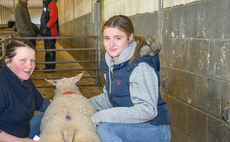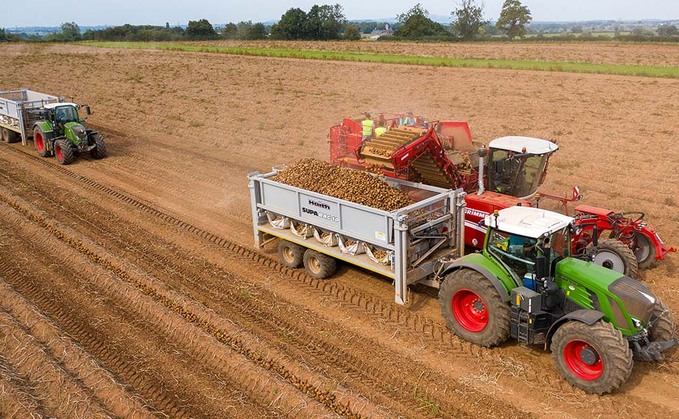
Haith's bagging trailer has the potential to cut costs for potato growers, by simplifying logistics and handling. Geoff Ashcroft spoke to a Herefordshire grower who has invested in two of them.
Harvesting 360 hectares of potatoes around Herefordshire, Worcestershire and Gloucestershire, grower BH Savidge and Son accept that logistics are pushed to the limit.
"There are several challenges to manage when land is spread over such a wide area," says Mark Savidge based at Rock Farm, Lea near Ross-on-Wye. "Weather conditions, available haulage, storage and logistics all fall under the spotlight, and all have an influence on how we keep up with processor demand."
But the arrival of two Haith Supabag 10 crop trailers has improved logistics considerably, giving this grower the opportunity to send one-third of his crop directly from field to processor. "We supply 80 per cent of our crop to Lamb Weston-Meijer, which loaned us a trailer to try in 2019," he says. "We were so convinced of the process that we bought two of them for the 2020 season, and we lifted and bagged 4,000 tonnes of the 8,000 tonnes we supply them.
"Compared to traditional methods of hauling back to a grading line for additional cleaning and sorting into specialised bulk transport, this is a game changer for us," he says. "Bags can be loaded into a curtainside trailer - usually as a back-load - which increases flexibility with onward haulage."
He says that transporting crop away from his Grimme Varitron 220 self-propelled harvester could require up to eight tractors and trailers on the longer hauls. But bagging in-field requires just two. "To get the land we require, we are travelling further and further from base," he says. "While we can often make use of remote sites, hauling crop back to our own grading line is costly and time consuming.
"Tractors are inefficient for road haulage and it costs us £15/tonne, where a lorry works out at about £7/tonne," he says. "Lorries are our preference, but with specialised transport you cannot always get what you need, when you need it. Now we can use anyone with a curtainside trailer."
He says that with Grimme's help, the farm increased the size of the harvester's four-man picking table to accommodate a team of six, allowing BH Savidge to sort in-field to meet the specification for Lamb Weston-Meijer. Getting a quality crop of potatoes out of the ground and to the processor, as cost-effectively as possible, is where profit is won or lost for this grower. And the Supabag 10 crop trailer now appears to provide the answer.
But to be successful, it requires a partnership approach between grower and processor, and each processor has very different requirements. "We work closely with Lamb Weston at Wisbech, which uses everything we supply for the frozen chip market," explains Mr Savidge. "And the Supabag trailer has overwhelmingly simplified this process.
"We can now give the company the volume of crop it wants, when it wants it, by lifting and bagging crop in preparation for transport. It is a very flexible approach," he says. "Harvesting potatoes is no longer a stop-start process that has to fit in with specialised haulage. Nor are we expected to lift in less than ideal conditions to meet demand for Lamb Weston-Meijer. And that also benefits our land owners, because we can choose to lift in more favourable conditions, getting the crop ready for collection."
The 13 tonne capacity Supabag trailer uses a large, central body that sits above 10 funnels; five on each side of the trailer. Beneath each funnel is a 1.3t capacity bulk bag. During operation, the trailer runs alongside the harvester and is filled in-field like any other trailer. When full, it is driven to the headland or a nearby yard, where suitable hard-standing allows bag-filling to begin. This process sees the trailer body raised by four hydraulic rams; one on each corner of the body. A pto-driven, self-contained hydraulic system ensures tractor capacity is not a limiting factor.
As the body is raised, crop simultaneously flows gently into the bags below. When full, the bag-carrying arms are extended sideways from beneath their hoppers, to position the bags clear of the trailer, before the body is lowered, placing two rows of five bags on the ground.
The arms can then be retracted and the trailer driven away, ready to be refitted with 10 empty bags, so the process can be repeated. "We are not waiting for boxes, or special bulk trailers," says Mr Savidge. "And a pallet of bags can easily be delivered to farm using a van."
A telehandler is then used to reposition the full bags, ready for onward transport; often by a curtainside trailer, simplifying and speeding up logistics. "We will also get extra versatility from the trailers with our seed crop," he says.
Grown within a 240 hectare block some 40 miles from base, the farm's seed crop will be lifted and bagged this season. Transport will be by lorry, to reduce haulage costs back to Rock Farm, where the crop will be graded and stored in boxes, ready for planting the following spring. "We have also bought a bag tipper so that we can unload them into our grader," he adds. "And all over-sized seed will be bagged and sold off, for frying."
This trailer innovation was first developed by Haith Engineering in conjunction with Higgins Agriculture, which once had a fleet of about 17 trailers. There are about 10 units working in the UK and the concept is not confined exclusively to potatoes; any produce capable of being transported in bulk bags could be handled this way says Haith Engineering, which is currently working with Grimme to exploit the two companies' knowledge of harvesting and handling.
BH Savidge trailer operator, Pete Aubrey and harvester driver, Jamie Manns work together to ensure the process is as smooth and efficient as possible. And having a second Supabag trailer means harvesting can continue uninterrupted while the other is being unloaded.
"There does need to be a more considered approach when filling the trailer," says Mr Manns. "Over filling can result in crop spillage over the top of the bags when the trailer is raised, and under-filling means bags go away too light, which has an impact on haulage."
Mr Aubrey agrees: "It is not as simple as just filling a trailer. Care is also needed when transferring crop into the bags and unloading the trailer. At full height, there is a lot of weight up in the air, so level ground is essential when off-loading the bags.
"And I have found that when the bags are lowered, they can sit quite close to the trailer," he says. "The answer is to pull the arms back in a bit once the bags have been lowered, then re-lift and push out again. It just gives extra clearance on both sides."
He also says that it is worth taking the time to ensure bags are refitted properly. "If conditions are windy, the bags can be blown around under the funnels," explains Mr Aubrey. "I do make an extra check on the bags, just before I draw under the harvester. Once crop starts to fill the trailer, you are committed to unloading into the bags."
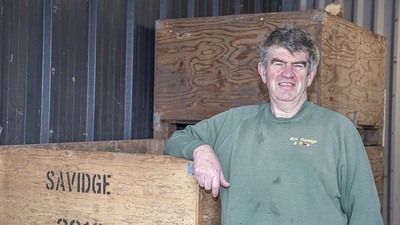
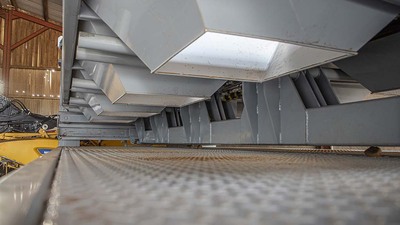

Hydraulics
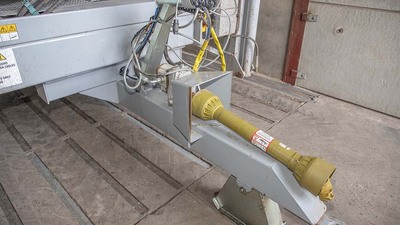
The trailer has a self-contained hydraulic system, and ensures tractor capacity is not a limiting factor.
Unloading sequence:
UL 1
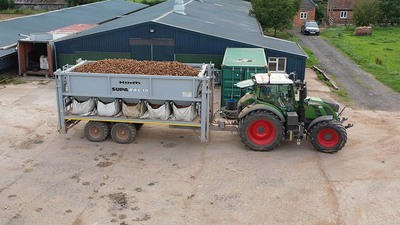
As the trailer's body is raised, bags are gently filled.
UL 2
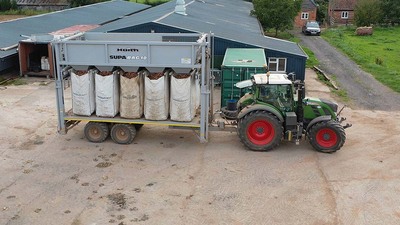
Trailer height needs to accommodate the depth of the bags.
UL 3
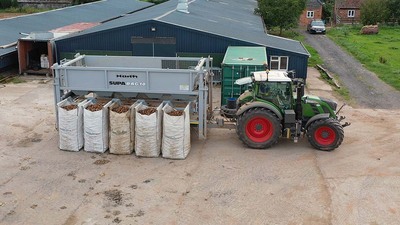
Full bags are pushed out, sideways before being lowered to the ground.




















